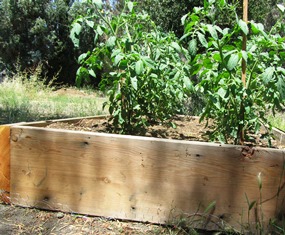Critter-proofing Your Bulbs
I planted bagfuls of tulips, daffodils, crocus, and grape hyacinths over the last two years in the autumn. The daffodils are blooming now and the other bulbs in my garden have plenty of foliage.
Because voles, moles, gophers, squirrels, raccoons, and other critters will dig and eat the bulbs and deer will devour the blooms at first blush of color, a savvy gardener must figure out how to protect these beautiful flowers.

The bees are drawn to the sweet scent of narcissus that have now naturalized in my Henny Penny Farmette gardens
Throughout the Midwest of my youth, hillsides, front yards, and cemeteries were always places where daffodils grew in perfusion. Along with the arrival of robins and other songbirds, these flowering bulbs herald the coming light and warmth of spring. I’ve lost plenty of these plantings myself so have some tips to help you prevent such a loss.
Seven ways to protect flowering bulbs.
1. Grow them behind a double fence barrier. Deer can jump high and might go over one fence, but not a second one built near the first.
2. Use mesh to deter moles, voles, gophers, groundhogs, and other digging critters.
3. Erect fences that are at least three feet tall and with at least a foot buried beneath the earth.
4. Plant in raised beds covered with mesh. The bulbs will be protected while the foliage and blooms poke through toward the light.
5. Clean up the area in the fall after planting the bulbs. That way, critters won’t be attracted to your bulb beds.
6. Consider using deer-repellent sprays on tulips and growing deer-resistant bulbs.
7. Use ammonia-soaked rags in coffee cans or old planting buckets around the garden to repel pests with a keen sense of smell such as rabbits and opossums.
* * *
Enjoy reading about farming topics? Check out my cozy mysteries–A BEELINE TO MURDER and also THE MURDER OF A QUEEN BEE (both in the Henny Penny Farmette series from Kensington Publishing). Kobo Books has A BEELINE TO MURDER on sale. Check out this incredible deal on https://www.kobo.com/us/en/search?Query=Meera+Lester
My farmette and bee-based novels are chocked full of recipes, farming tips, chicken and beekeeping tips, sayings and, of course, a charming cozy mystery. For more info, click on the links under the pictures.
The books are available through online retailers such as Amazon, Barnes & Noble, Target, BAM, Kobo Books, and Walmart as well as from traditional bookstores everywhere.
See, http://tinyurl.com/hxy3s8q
A Beeline to Murder is the debut novel that launched the Henny Penny Farmette series of mysteries. Initially released as a hardcover novel and in e-book format, it is now available as a mass market paperback.
See, http://tinyurl.com/h4kou4g
NEWLY RELEASED! This, the second cozy mystery in the Henny Penny Farmette series, is garnering great reviews from readers and industry publications.
Outwitting the Moles
Last year, our garden went under siege to moles, voles, and gophers. They drove us crazy with tunnels, tracks, and earth mounds–the means to devour our newly planted bulbs and plants. We didn’t see signs of the voles but we knew we had them, too, when one showed up drowned in a post hole after a rainstorm.
But whether the rodent is a gopher, vole, or mole, they are unwanted pests in my garden. This year, my husband and I decided they could roam around if they wanted, but we were going to protect our plants one way or another.
For our heirloom blue tomatoes, Carlos built four -by-six feet boxes to hold soil. For each, we nailed small-hole poultry wire over the bottom, then flipped the box over to set in place on the ground.
We then filled the box with alternating layers of natural soil, compost, and dried horse manure (any type of manure must be dried and aged or it’ll be hot and kill your plant).
We planted, staked, and watered the tomatoes. We’ve seen no evidence of rodent tunnels despite having planted in an area where we know there are tunnels. We’re thrilled with the result. I just may have to do my whole garden in boxes next year.
Remind Me Again, What Good Are Gophers?

Cecile Brunner forms an arch over a statue of the Virgin Mary in one of the prettiest and most peaceful areas of my garden
The lovely Cecile Brunner rose that serves as the anchor for a small meditation garden on the northwest side of my little farmhouse suddenly appears yellowed, leafless, and lifeless. Honest to goodness, she looks like she’s croaked. It’s certainly a strange turn of events, since she had numerous new canes and the leaves were shiny and healthy only a week ago.
There is a small eruption of new dirt nearby–suggestive of moles (insect eaters) and gophers (vegetarians) and maybe voles–(voles eat roots but don’t leave mounds). So my rose problem might actually be two-fold–either way–it’s underground.
I could dig and back fill those tunnels with dirt and maybe I should. I’ve heard you can break a leg stepping into a gopher hole and I’m not talking livestock here. I wonder if the vole and gopher are sharing a network of tunnels down there dead-ending in the gopher’s bunker.
I gave the poor rose a big drink of water as soon as I discovered her condition, not knowing what else to do. As I stood there, watering with hose in hand, I saw the earth around the rose’s root cave in. Seriously?
So I’m thinking there must be a one heck of a big tunnel. This is war! I decide to stick the hose right into the tunnel and fill it with as much water as that hole will hold . . . and then some.
Strangely, while I’m dealing with the rose problem, I look past the fresh dirt mound and notice that one of the Dutch purple irises in a bed of a hundred or more has broken into full bloom. What gives? Those beauties normally bloom around Easter. I wonder why the voles haven’t attacked the rhizomes of the irises.
The condition of the Cecile Brunner climbing rose breaks my heart. Maybe she’ll spring back to life to bloom again next spring. For now, I’ll clip the beautiful iris and tuck it into a vase with some roses from other bushes on the farmette. That done, I’ll put an all-out effort into finding out how to get rid of those underground buck-tooth bandits . . . for good. Feel free to leave me your ideas. I’ve tried almost everything I’ve read on the Internet.
Moles and More
Fresh mounds of dirt and surface runways have newly populated the rear of the Henny Penny Farmette. I recognize the dirt mounds as telltale signs of the presence of either moles, gophers, or voles.
Since the mounds are small and shaped like volcanoes with ridges on the soil surface, my best guess is that my night visitors are moles–mammals that live underground and create a vast network of tunnels.
Of the three, moles are actually the more preferable since they do not go after plants and bulbs. As insectivores, they eat earthworms and grubs. If you have a flower beds and a lawn, that’s a perfect place for them to find food . . . and they need a lot. By some estimates, they need to eat their body weight daily.
There are ways to detect which little creature you have in your lawn. Moles leave fresh dirt mounds piled like volcanoes. Moles leave subterranean pathways that pop up the soil to look like ridges.
Voles leave no mounds. Pocket gophers leave a horseshoe-shaped mounds of dirt.
Which brings me back to the much maligned mole. Whereas voles are voracious root eaters, moles actually can be beneficial to a garden, eating worms, bugs, and grubs but they don’t eat plants or bulbs. They will starve if fed a diet of only plants. See, http://www.ipm.ucdavis.edu/PMG/PESTNOTES/pn74115.html
Their shallow tunnels aerate the garden soil. And if you find the eruptions unsightly, you simply have to tamp down the raised areas. Scientists have studied methods of getting rid of moles and say none of the home remedies (castor oil, shattered glass, chewing gum, etc.) really works. That’s not to say they can’t be banished; it’s just difficult to find a humane way to do it.
If we gardeners can’t get rid of them humanely, perhaps we could just learn to live with them. Another option is to attract barn owls to your property, since they love dining on moles, gophers, rats, mice, and other rodents. If you build a barn owl nest, they might take up residence. Mother Nature’s eco-control is always best. See, ftp://ftp-fc.sc.egov.usda.gov/CA/news/Publications/wild_habitat/owl_nest.pdf
Stinking Away Gophers
In anticipation of the city-wide garage sale this weekend, I’ve been walking around the property, looking for things to sell and making a to-do list. That is, until my foot disappeared into a freshly dug tunnel. Now all I can think about is how to get rid of the gophers.
A newly erupted, fan-shaped mound of dirt with a hole off to the side suggested a gopher had been tunneling underground in my yard. How do I know it’s a gopher and not a mole? The fan-shape ridge of soil and complete disappearance of plants are telltale signs of the presence of a gopher.
Moles tunnel but don’t consume plants. They feed on grubs and worms. Their soil ridges are shallow and near the surface.
Frankly, I don’t mind the moles as much as the gophers. Moles are harmless and their tunnels, although ugly, aerate the soil. But gophers are destructive. In the last two weeks, I have witnessed how a gopher can take down a lush garden. A number of organic plants, tomatoes, cilantro (young leafy coriander), and hot peppers that were planted last month have been decimated in less than a week by gophers.
I have searched magazines, newspapers, and the Internet for ways to get rid the pesky critters. I don’t want to use poison or cages. I am more interested in using all-natural caster oil granules. But I haven’t seen a lot of testimonials about the effectiveness of the granules in repelling gophers. The caster oil does not kill gophers. When the granules are watered, they release a scent that is supposed to repel gophers and moles. In fact, you can direct the vermin from your property by strategic application of the granules–1 pound to 1,000 square feet. A spreader makes it easy to spread the granules evenly.
So, I’ve added buying and spreading caster oil granules to my list. I’m going to stink them away.
Post script: Several days have passed with no new gopher mounds on the farmette, so I believe the caster oil method worked.
 Facebook
Facebook Goodreads
Goodreads LinkedIn
LinkedIn Meera Lester
Meera Lester Twitter
Twitter













